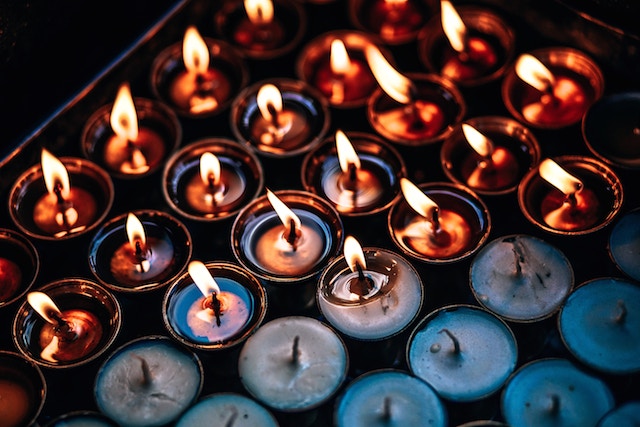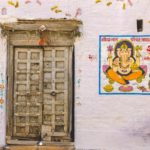The Biggest Lesson I Learned at an Exorcism in India

I wasn’t sure what disturbed me more—the constant, high-pitched shrieks, or the people crouched on the cold, cement floor, chained to poles. I kept the scarf tied close around my head and face, as is customary for women within the walls of the Mira Datar Shrine. Even though my head covering felt like a layer of protection that could shield me, it just wasn’t enough. I periodically stared at the floor, giving my eyes a break from the mass exorcism taking place before me.
Before I go any further, I think it is important for you to know how I arrived in Unava, a small village in Gujarat, India, to begin with. I grew up in a small town of 4,000 people in rural Illinois. Two-thirds of the population were Amish. This town was situated smack-dab between a corn and a bean field, and there was a celebration when the first (and only) stoplight was installed.
The citizens of Fairbury held conservative beliefs about religion, politics, and people of color. As I got older and wished to explore the world and its fascinating cultures, I felt stifled and stunted by my small-town surroundings. Since then, I have been on a perpetual quest to learn as much as I can about people and foreign lands—and to break free from the limiting beliefs that influenced me as a child and young adult.
Eyes rolled into the backs of heads, chains rattled on the poles as the most violent tried to break free.
I often find myself packing up, heading to a faraway land, and letting the adventure unfold once I reach my destination. When I arrived in India to volunteer with Living Smile at the Ghandi Leprosy Society, I entered a world I had only been able to previously witness through books and documentaries.
On my first day, I met a couple from San Francisco who were in India for the seventh time. I sat with them and listened to their stories, gathering several recommendations for unique and intimate ways to experience the culture of India. Deborah and Gerald insisted that I hire a Muslim driver named Shaikh so I could take a day trip to a few sights outside of Ahmedabad.
As our day came to a close, we entered the Sufi Shrine, Mira Datar. We removed our shoes at the entrance, covered our heads, and crossed the threshold. This mosque was a humble structure of concrete and plaster, which had been painted sea green. The air smelled of incense and roses, and was charged with the energy of the mujarwars, or faith healers. It is believed that mujarwars can heal the mentally ill who are believed to be afflicted by black magic, evil spells, and bad curses.
It was a true community of mentally-ill and mentally-well, all focused on helping one another through a difficult time.
Every night, around six o’clock, the faith-healing ceremony starts. I took my seat off to the side, on a concrete slab, and tried to blend in. The ceremony started with Islamic chanting, which lasted for about 15 minutes. Then, the drumming began. There must have been five or more drummers behind the patterned curtain, and their forceful, choreographed beating caused my body to vibrate.
The combination of chanting, drumming, and incense fueled the ceremony, and within a few minutes, hundreds of participants began to shriek, pace, stomp, and throw themselves against the concrete pillars. Eyes rolled into the backs of heads, chains rattled on the poles as the most violent tried to break free. One woman used her scarf to attempt strangulation.
Check out Pink Pangea’s Writing, Yoga, and Meditation Retreats.
Family members must attend the ceremony with their loved ones. Many have been housed near the shrine for months and years, attending every night, hoping that the evil spirits will leave so they can all get back to a normal life. It was not uncommon to see family members helping constrain and protect the afflicted of other families during the exorcism. It was a true community of mentally-ill and mentally-well, all focused on helping one another through a difficult time.
As the ceremony came to a close, I tried to process all that I had witnessed. At no point was I terrified or “freaked-out”. I didn’t feel like I’d intruded either, which was my concern from the beginning. But what I was left with, overall, was a positive feeling due to the spirit of compassion and community present within those walls. No one in the mosque was looked down upon, or stigmatized.
The families hadn’t locked the unwell up in a hospital for the mentally ill, only to be forgotten and abandoned, as is common in the West. The afflicted were supported and loved. It is a lesson I have carried back home with me, and one that will remain with me forever.
India Exorcism: The Biggest Lesson I Learned at an Exorcism in India
Have traveled to India? How was your trip? Email us at [email protected] for information about sharing your experience and advice with the Pink Pangea community. We can’t wait to hear from you.
India Exorcism: The Biggest Lesson I Learned at an India Exorcism top photo by Igor Ovsyannykov on Unsplash








